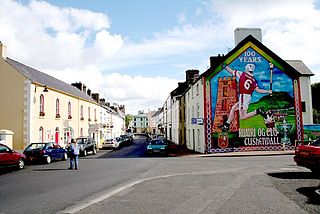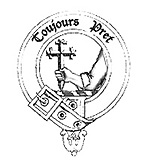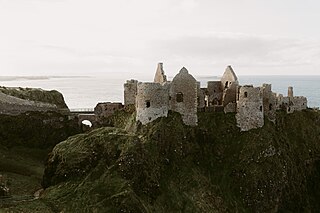
Ballycastle is a small seaside town in County Antrim, Northern Ireland. It is on the north-easternmost coastal tip of Ireland, in the Antrim Coast and Glens Area of Outstanding Natural Beauty.
Somhairle Buíodh MacDonnell, known as Sorley Boy MacDonnell, whose last name was also given as MacDonald, was a Gaelic chief, the son of Alexander Carragh MacDonnell, 5th of Dunnyveg, of Dunyvaig Castle, lord of Islay and Cantire, and Catherine, daughter of the Lord of Ardnamurchan, both in Scotland. MacDonnell is best known for establishing the MacDonnell clan in Antrim, Ireland, and resisting the campaign of Shane O'Neill and the English crown to expel the clan from Ireland. Sorley Boy's connection to other Irish Roman Catholic lords was complicated, but also culturally and familiarly strong: for example, he married Mary O'Neill, the daughter of Conn O'Neill. He is also known in English as Somerled and Somerled of the yellow hair.

The Ould Lammas Fair is a traditional fair held in Ballycastle, County Antrim, Northern Ireland, every year on the last Monday and Tuesday of August. It is associated with the Lammas harvest festival.

The Glens of Antrim, known locally as simply The Glens, is a region of County Antrim, Northern Ireland. It comprises nine glens (valleys), that radiate from the Antrim Plateau to the coast. The Glens are an area of outstanding natural beauty and are a major tourist attraction in north Antrim.

Olderfleet Castle is a four-storey towerhouse, the remains of which stand on Curran Point to the south of Larne Harbour in Larne, County Antrim, Northern Ireland. The place name of Olderfleet may be a corruption of Ulfrecksfiord, the Viking name for Larne Lough.

Glenarm is a village in County Antrim, Northern Ireland. It lies on the North Channel coast north of the town of Larne and the village of Ballygalley, and south of the village of Carnlough. It is situated in the civil parish of Tickmacrevan and the historic barony of Glenarm Lower. It is part of Mid and East Antrim Borough Council and had a population of 568 people in the 2011 Census. Glenarm takes its name from the glen in which it lies, the southernmost of the nine Glens of Antrim.

La Girona was a galleass of the 1588 Spanish Armada that foundered and sank off Lacada Point, County Antrim, on the night of 26 October 1588, after making its way eastward along the north coast of Ulster. The wreck is noteworthy for the great loss of life that resulted and the treasures recovered.

Cushendall, formerly known as Newtownglens, is a coastal village and townland in County Antrim, Northern Ireland. It is located in the historic barony of Glenarm Lower and the civil parish of Layd, and is part of Causeway Coast and Glens district.

Kinbane Castle is located in County Antrim, Northern Ireland, on a headland between Ballycastle and Ballintoy. The name comes from the Irish for "white head", referring to the limestone of the promontory. Nowadays, the castle is largely destroyed. Kinbane Castle is a State Care Historic Monument sited in the townland of Cregganboy, in Moyle District Council area, at grid ref: D0876 4383. The area surrounding Kinbane Castle is a Scheduled Historic Monument, grid ref: D0879 4381. The site also has views of Rathlin Island and Dunagregor Iron Age fort.
The Battle of Glentaisie, was an Irish battle fought in the north of Ulster on 2 May 1565. The result was a victory for Shane O'Neill over the Clan MacDonald of Dunnyveg. The conflict was a part of the political and military struggle, involving the English and occasionally the Scots, for control of northern Ireland. Although the MacDonalds were a Scottish family, based principally on the island of Islay in the Hebrides, they had long been associated with the Gaelic polity rather than the Kingdom of Scotland.

Clan MacDonald of Dunnyveg, also known as Clan Donald South, Clan Iain Mor, Clan MacDonald of Islay and Kintyre, MacDonalds of the Glens (Antrim) and sometimes referred to as MacDonnells, is a Scottish clan and a branch of Clan Donald. The founder of the MacDonalds of Dunnyveg is Eòin Mòr Tànaiste Mac Dhòmhnaill, a son of Iain Mic Dhòmhnaill and Margaret Stewart of Scotland, daughter of King Robert II. Members of the clan actually pronounced and spelled their name M'Connall due to the Gaelic pronunciation of the name Mac Domhnuill thus giving rise to the surname McConnell and its variants. While historically recognised as a clan by the Court of the Lord Lyon, it is now an armigerous clan as it no longer has a chief. The last chief was Sir James MacDonald, 9th of the Clan MacDonald of Dunnyveg or Clan Donald South, who died in London in 1626.

The MacDonnells of Antrim, also known as the MacDonnells of the Glens, are a branch in Ireland of the Scottish-based Clan Donald. Initially part of Clan MacDonald of Dunnyveg, the MacDonnells of Antrim became their own branch in 1558 when Somhairle Buidhe MacDonnell obtained the lordship of the territory in Ireland from James MacDonald, 6th chief of the Clan MacDonald of Dunnyveg.

Glenarm Castle, Glenarm, County Antrim, Northern Ireland, is the ancestral home of the Earl of Antrim.
Dunaneeny Castle is a ruined castle on the outskirts of Ballycastle in County Antrim, Northern Ireland. The castle was home to the chiefs of Clan MacDonald of Dunnyveg and later the MacDonnells of Antrim. The castle is purported to be the birthplace of Scottish-Irish chief Sorley Boy MacDonnell.

Rathlin Castle, also known as Bruce's Castle, was a castle on Rathlin Island off the coast of County Antrim in Northern Ireland.

The Route was a medieval territory in Gaelic Ireland, located on the north-east coast of Ulster. It stretched between Coleraine and Ballycastle and as far south as the Clogh River. Originally part of Twescard, a county of the Earldom of Ulster, it was later ruled by the MacQuillans and then the MacDonnells.

Clan Bissett is a Scottish clan. The clan is recognised by the Lord Lyon King of Arms but does not have a clan chief recognised by the Lord Lyon King of Arms, therefore the clan has no standing under Scots Law. Clan Bissett is considered an armigerous clan, meaning that it is considered to have had at one time a chief who possessed the chiefly arms; however, no one at present is in possession of such arms. The surname Bissett is also considered a sept of the Clan Fraser of Lovat.

The history of the Bissett family in Ireland can be studied independently from that of the originally identical family in Scotland, because of their unique experience following their arrival in Ulster in the early or mid-13th century. Here, while still remaining involved in Scottish affairs, the Bissetts would establish themselves as the Lords of the Glens of Antrim and quickly become equally, then eventually more involved in the politics of the Irish province, becoming among the most Gaelicised of all the so-called Anglo-Norman families in Ireland. The heads of the leading branch of the family soon adopted the Gaelic lineage style Mac Eoin Bissett, by which they are known in the Irish annals, and which translates as "Son/Descendant of John Byset", after a prominent ancestor born in Scotland. In a number of English and Anglo-Norman sources the same head of the family is referred to as the Baron Bissett, also with variants.
Margery Byset was an Irish noblewoman belonging to the Bissett family whose marriage to John Mór Tanister MacDonnell in 1399 laid the basis for the Clan Donald claim to the Glens of Antrim, the lordship of which her family had established in the 13th century. She is the ancestress of the Clan MacDonald of Dunnyveg.
John Byset the Elder, Lord of the Aird was a Scoto-Norman nobleman who is the progenitor of the Bissett family of the Glens of Antrim in medieval northeastern Ireland, present-day Northern Ireland.















